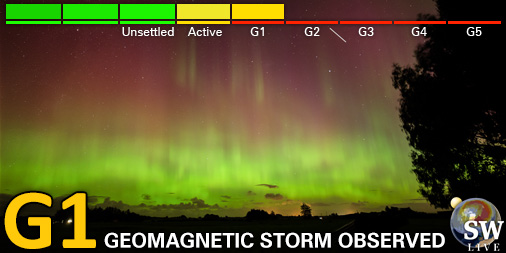Viewing archive of Wednesday, 10 April 2002
Solar activity report
Prepared by the NOAA © SWPC and processed by SpaceWeatherLive.com
Joint USAF/NOAA Report of Solar and Geophysical Activity
SDF Number 100 Issued at 2200Z on 10 Apr 2002IA. Analysis of Solar Active Regions and Activity from 09-2100Z to 10-2100Z
IB. Solar Activity Forecast
IIA. Geophysical Activity Summary 09-2100Z to 10-2100Z
IIB. Geophysical Activity Forecast
III. Event Probabilities 11 Apr to 13 Apr
| Class M | 60% | 60% | 60% |
| Class X | 10% | 10% | 10% |
| Proton | 05% | 05% | 05% |
| PCAF | yellow | ||
IV. Penticton 10.7 cm Flux
Observed 10 Apr 194 Predicted 11 Apr-13 Apr 195/190/185 90 Day Mean 10 Apr 203
V. Geomagnetic A Indices
Observed Afr/Ap 09 Apr 002/006 Estimated Afr/Ap 10 Apr 006/008 Predicted Afr/Ap 11 Apr-13 Apr 004/008-008/010-012/015
VI. Geomagnetic Activity Probabilities 11 Apr to 13 Apr
| A. Middle Latitudes | |||
|---|---|---|---|
| Active | 10% | 15% | 20% |
| Minor storm | 01% | 05% | 10% |
| Major-severe storm | 01% | 01% | 05% |
| B. High Latitudes | |||
|---|---|---|---|
| Active | 15% | 15% | 20% |
| Minor storm | 05% | 05% | 10% |
| Major-severe storm | 01% | 01% | 05% |
All times in UTC
Current data suggests there is a high possibility for aurora to appear at the following high latitude regions in the near future
Iqaluit, NUNuuk
Tórshavn
Oulu, Rovaniemi, Sodankylä
Reykjavik
Tromsø
Kiruna, Luleå
Current data suggests there is a moderate possibility for aurora to appear at the following high latitude regions in the near future
TrondheimSundsvall, Umeå
Current data suggests there is a slight possibility for aurora to appear at the following high latitude regions in the near future
KuopioBergen
Current data suggests there is a slight possibility for aurora to appear at the following middle latitude regions in the near future
Thunder Bay, ONTampere, Turku
Petrozavodsk
Latest news
Latest forum messages
Support SpaceWeatherLive.com!
A lot of people come to SpaceWeatherLive to follow the Sun's activity or if there is aurora to be seen, but with more traffic comes higher server costs. Consider a donation if you enjoy SpaceWeatherLive so we can keep the website online!

Latest alerts
00:18 UTC - Hemispheric Power Index
The OVATION model predicts the Hemispheric Power Index to reach 101GW at 01:06 UTC
Friday, 21 March 2025
23:45 UTC - Geomagnetic activity
Minor G1 geomagnetic storm (Kp5) Threshold Reached: 23:30 UTC
23:12 UTC - Hemispheric Power Index
The OVATION model predicts the Hemispheric Power Index to reach 77GW at 00:01 UTC
19:39 UTC - Hemispheric Power Index
The OVATION model predicts the Hemispheric Power Index to reach 53GW at 20:34 UTC
19:00 UTC - Geomagnetic activity
Minor G1 geomagnetic storm (Kp5) Threshold Reached: 18:55 UTC
Space weather facts
| Last X-flare | 2025/02/23 | X2.0 |
| Last M-flare | 2025/03/21 | M1.2 |
| Last geomagnetic storm | 2025/03/14 | Kp6- (G2) |
| Spotless days | |
|---|---|
| Last spotless day | 2022/06/08 |
| Monthly mean Sunspot Number | |
|---|---|
| February 2025 | 154.6 +17.6 |
| March 2025 | 138.4 -16.2 |
| Last 30 days | 140.3 -10.9 |




